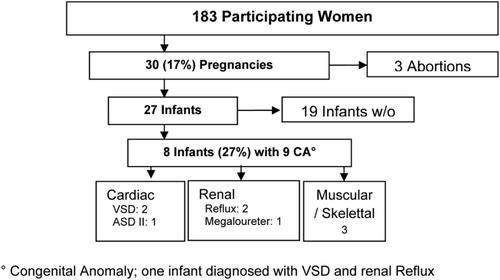下载PDF
{"title":"暴露于电离辐射的医务人员的后代有致畸风险的证据?!","authors":"Awi Wiesel, Gabriela Stolz, Annette Queisser-Wahrendorf","doi":"10.1002/bdra.23532","DOIUrl":null,"url":null,"abstract":"<div>\n \n <section>\n \n <h3> Background</h3>\n \n <p>The evidence concerning safety of occupational exposure to ionizing radiation on teratogenic effects mainly relies on animal models, disaster epidemiology and experience in cancer etiology. Following an explorative result on maternal exposure in medical occupations we conducted a feasibility study, addressing congenital anomalies (CA) in the offspring of health workers potentially exposed to radiation.</p>\n </section>\n \n <section>\n \n <h3> Methods</h3>\n \n <p>In a prospective follow-up study, we enrolled women, identified by mandatory registration at the office of radiation protection as wearing a dosimeter. The participating women answered a questionnaire and if pregnant agreed to an examination of their infant. CA were diagnosed and categorized, and demographic and anamnestic findings (including dosimeter values) were ascertained. Mainz Birth Registry data were used for comparison, and a nonresponder analysis was performed.</p>\n </section>\n \n <section>\n \n <h3> Results</h3>\n \n <p>Answers were received from 286 of 604 (51%) women exposed and 183 (30.3%) of them participated in the study including 88 nonparticipants who provided exposure data only. Further sources of ionizing radiation and other factors relevant for CA did not differ between the groups. Thirty pregnancies occurred among the participants. Eight of the resulting 27 infants were diagnosed with CA (30%) compared with 6.2% of the comparison group.</p>\n </section>\n \n <section>\n \n <h3> Conclusion</h3>\n \n <p>Previous explorative findings were corroborated by this feasibility study. The increased prevalence for CA could not be explained by any other factor. A preferable prospective active design is achievable, and the participation rate is essential to calculate valid results and answer this important issue. Birth Defects Research (Part A) 106:475–479, 2016. © 2016 Wiley Periodicals, Inc.</p>\n </section>\n </div>","PeriodicalId":8983,"journal":{"name":"Birth defects research. Part A, Clinical and molecular teratology","volume":"106 6","pages":"475-479"},"PeriodicalIF":0.0000,"publicationDate":"2016-06-14","publicationTypes":"Journal Article","fieldsOfStudy":null,"isOpenAccess":false,"openAccessPdf":"https://sci-hub-pdf.com/10.1002/bdra.23532","citationCount":"3","resultStr":"{\"title\":\"Evidence for a teratogenic risk in the offspring of health personnel exposed to ionizing radiation?!\",\"authors\":\"Awi Wiesel, Gabriela Stolz, Annette Queisser-Wahrendorf\",\"doi\":\"10.1002/bdra.23532\",\"DOIUrl\":null,\"url\":null,\"abstract\":\"<div>\\n \\n <section>\\n \\n <h3> Background</h3>\\n \\n <p>The evidence concerning safety of occupational exposure to ionizing radiation on teratogenic effects mainly relies on animal models, disaster epidemiology and experience in cancer etiology. Following an explorative result on maternal exposure in medical occupations we conducted a feasibility study, addressing congenital anomalies (CA) in the offspring of health workers potentially exposed to radiation.</p>\\n </section>\\n \\n <section>\\n \\n <h3> Methods</h3>\\n \\n <p>In a prospective follow-up study, we enrolled women, identified by mandatory registration at the office of radiation protection as wearing a dosimeter. The participating women answered a questionnaire and if pregnant agreed to an examination of their infant. CA were diagnosed and categorized, and demographic and anamnestic findings (including dosimeter values) were ascertained. Mainz Birth Registry data were used for comparison, and a nonresponder analysis was performed.</p>\\n </section>\\n \\n <section>\\n \\n <h3> Results</h3>\\n \\n <p>Answers were received from 286 of 604 (51%) women exposed and 183 (30.3%) of them participated in the study including 88 nonparticipants who provided exposure data only. Further sources of ionizing radiation and other factors relevant for CA did not differ between the groups. Thirty pregnancies occurred among the participants. Eight of the resulting 27 infants were diagnosed with CA (30%) compared with 6.2% of the comparison group.</p>\\n </section>\\n \\n <section>\\n \\n <h3> Conclusion</h3>\\n \\n <p>Previous explorative findings were corroborated by this feasibility study. The increased prevalence for CA could not be explained by any other factor. A preferable prospective active design is achievable, and the participation rate is essential to calculate valid results and answer this important issue. Birth Defects Research (Part A) 106:475–479, 2016. © 2016 Wiley Periodicals, Inc.</p>\\n </section>\\n </div>\",\"PeriodicalId\":8983,\"journal\":{\"name\":\"Birth defects research. Part A, Clinical and molecular teratology\",\"volume\":\"106 6\",\"pages\":\"475-479\"},\"PeriodicalIF\":0.0000,\"publicationDate\":\"2016-06-14\",\"publicationTypes\":\"Journal Article\",\"fieldsOfStudy\":null,\"isOpenAccess\":false,\"openAccessPdf\":\"https://sci-hub-pdf.com/10.1002/bdra.23532\",\"citationCount\":\"3\",\"resultStr\":null,\"platform\":\"Semanticscholar\",\"paperid\":null,\"PeriodicalName\":\"Birth defects research. Part A, Clinical and molecular teratology\",\"FirstCategoryId\":\"1085\",\"ListUrlMain\":\"https://onlinelibrary.wiley.com/doi/10.1002/bdra.23532\",\"RegionNum\":0,\"RegionCategory\":null,\"ArticlePicture\":[],\"TitleCN\":null,\"AbstractTextCN\":null,\"PMCID\":null,\"EPubDate\":\"\",\"PubModel\":\"\",\"JCR\":\"Q\",\"JCRName\":\"Medicine\",\"Score\":null,\"Total\":0}","platform":"Semanticscholar","paperid":null,"PeriodicalName":"Birth defects research. Part A, Clinical and molecular teratology","FirstCategoryId":"1085","ListUrlMain":"https://onlinelibrary.wiley.com/doi/10.1002/bdra.23532","RegionNum":0,"RegionCategory":null,"ArticlePicture":[],"TitleCN":null,"AbstractTextCN":null,"PMCID":null,"EPubDate":"","PubModel":"","JCR":"Q","JCRName":"Medicine","Score":null,"Total":0}
引用次数: 3
引用
批量引用


 求助内容:
求助内容: 应助结果提醒方式:
应助结果提醒方式:


